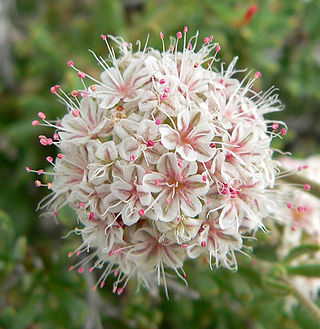
Eriogonum fasciculatum is a species of wild buckwheat known by the common names California buckwheat and flat-topped buckwheat. Characterized by small, white and pink flower clusters that give off a cottony effect, this species grows variably from a patchy mat to a wide shrub, with the flowers turning a rusty color after blooming. This plant is of great benefit across its various habitats, providing an important food resource for a diversity of insect and mammal species. It also provides numerous ecosystem services for humans, including erosion control, post-fire mitigation, increases in crop yields when planted in hedgerows, and high habitat restoration value.

Eleocharis is a virtually cosmopolitan genus of 250 or more species of flowering plants in the sedge family, Cyperaceae. The name is derived from the Greek words ἕλειος (heleios), meaning "marsh dweller," and χάρις (charis), meaning "grace." Members of the genus are known commonly as spikerushes or spikesedges. The genus has a geographically cosmopolitan distribution, with centers of diversity in the Amazon Rainforest and adjacent eastern slopes of the South American Andes, northern Australia, eastern North America, California, Southern Africa, and subtropical Asia. The vast majority of Eleocharis species grow in aquatic or mesic habitats from sea level to higher than 5,000 meters in elevation.
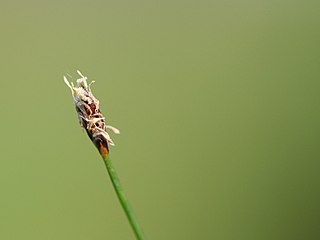
Eleocharis acicularis is a species of spikesedge known by the common names needle spikerush and least spikerush. It is widespread across Europe, central and southeastern Asia, North America and northeastern South America as far south as Ecuador. It is also found in Australia, where it is probably an introduced species.
Eleocharis vivipara is a species of flowering plant in the sedge family known by several common names, including umbrella hairgrass, sprouting spikerush, and viviparous spikerush. It is native to the southern United States from eastern Texas to eastern Virginia. It takes the form of a clump of thin stems. A spike of flowers appears at the tip of the stem. The plant may also reproduce by growing a plantlet and runners.
Eleocharis atropurpurea is a species of spikesedge known by the common name purple spikerush. This is an aquatic plant native to much of. It also has a wide distribution in temperate regions of North and South America and Asia. It is present in Europe, where it may be an introduced species for the most part.
Eleocharis geniculata is a species of spikesedge known by several common names, including bent spikerush and Canada spikesedge. This is a widespread plant of wet areas in the Americas, Asia, Africa, Australia, Madagascar, and some Pacific Islands. It is an annual spikesedge growing to a maximum height of about 40 centimeters. It has a few straw-colored leaves and many thin erect stems. The stems hold inflorescences of rounded spikelets each containing at least 10 tiny flowers. The flowers are covered with dark greenish-brown bracts. The fruit is a shiny purple-brown achene not more than a millimeter long.
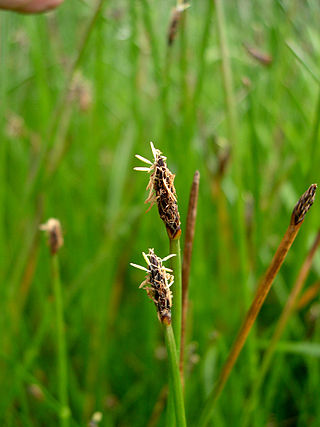
Eleocharis macrostachya is a species of spikesedge known by the common name pale spikerush.

Eleocharis pachycarpa is a species of spikesedge known by the common name black sand spikerush. This plant is native to southern South America but it grows in other parts of the world as an introduced species, such as Australia and the US states of California and Nevada.

Eleocharis quinqueflora is a species of spikesedge known by the common names fewflower spikerush and few-flowered spike-rush. It is widespread across Europe, North Africa, northern Asia, and North America. There are also isolated populations in Argentina and Chile.

Butomus is the only known genus in the plant family Butomaceae, native to Europe and Asia. It is considered invasive in some parts of the United States.

Eleocharis palustris, the common spike-rush, creeping spike-rush or marsh spike-rush, is a species of mat-forming perennial flowering plants in the sedge family Cyperaceae. It grows in wetlands in Europe, North Africa, northern and central Asia and North America. Eleocharis palustris is not easily distinguished from other closely related species and is extremely variable worldwide itself. The species epithet palustris is Latin for "of the marsh" and indicates its common habitat.

Artemisia nova is a North American species of sagebrush, known by the common name black sagebrush. It is "one of the most common shrubs in the western United States".

Boehmeria cylindrica, with common names false nettle and bog hemp, is an herb in the family Urticaceae. It is widespread in eastern North America and the Great Plains from New Brunswick to Florida to Texas to Nebraska, with scattered reports of isolated populations in New Mexico, Arizona, and Utah, as well as in Bermuda, Mexico, Central America, the West Indies, and South America.
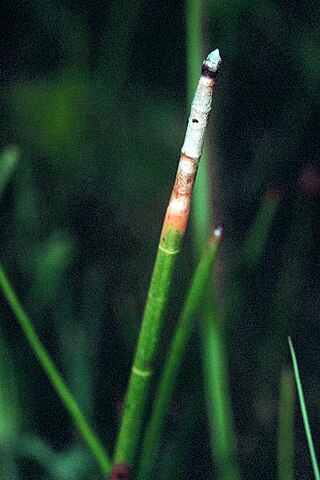
Eleocharis equisetoides, with common names including horsetail spike-rush, jointed spike-rush, spikesedge, and knotted spike-rush, is a plant species native to the United States and Ontario, usually in freshwater wetland areas. It is known primarily from the Atlantic coastal plain from Texas to Massachusetts, and the Great Lakes region, with scattered populations elsewhere.
Eleocharis acuta, commonly known as common spikerush or small spikerush, is a sedge of the family Cyperaceae that is native to Australia.

Eleocharis microcarpa, common names small-fruited spikesedge, spike-rush, small-fruited spike-rush and tiny-fruited spike-sedge, is a plant in the Eleocharis genus found in North America.
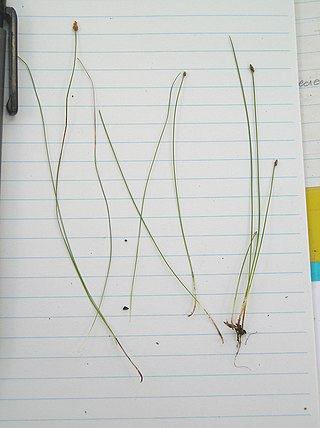
Eleocharis nitida is a species of flowering plant commonly called neat spikerush, it is a member of the sedge family Cyperaceae.

Juncus marginatus is a species of flowering plant, it is a type of rush with the common names of margined rush and grass-leaf rush.

Carex muehlenbergii is a species of flowering plant, it is a type of sedge. It is a grass-like plant in the family Cyperaceae. Its common names include sand sedge, Muhlenberg's sedge.
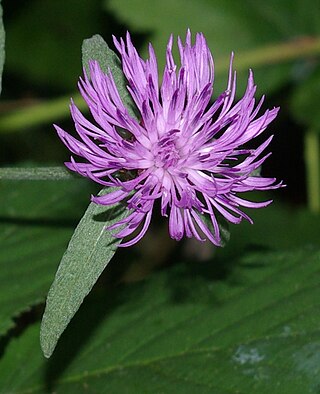
Meadow knapweed is a fertile hybrid between black knapweed and brown knapweed. It is also known by the common names of hybrid knapweed or protean knapweed. The taxonomic status of the species is uncertain, and meadow knapweed has been variously described as different species. The Flora of North America refers to meadow knapweed as the nothospecies Centaurea × moncktonii.

















